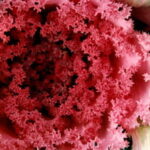Redbud trees produce beautiful red, pink or white blooms in the spring followed by broad heart-shaped leaves. They are medium-fast growing trees and are a great small ornamental tree for landscapes in most of the US. But did you know that there are several different varieties than the typical eastern redbud you may be familiar with? Here are some other types to look for that may be more appropriate for your locality. They all have yellow foliage in the fall. All varieties are related to the pea meaning they are legumes, and are able to capture nitrogen from the air and store it in their roots, so you never have to fertilize a redbud tree.
Western or California Redbud (Cercis canadensis ssp. Mexicana) A smaller type of red bud growing to 10 feet. Appropriate for USDA horticultural zones 7-9.
Mexican Redbud (Cercis canadensis ssp. Mexicana) One of my favorite red buds with small frilly leaves with a fuzzy texture when young. Very drought tolerant and grows well in alkaline soil. Will not look weak or stressed in late summer like most red buds species, even when planted in full sun. Grows to 25 feet. Zones 6-9.
Oklahoma Redbud (Cercis canadensis ssp. retisus) has glossy leathery leaves and is hard to tell apart from the Texas redbud except that it produces a bigger show of magenta flowers in the spring than other varieties and grows slightly taller to 30 feet. Although drought tolerant, it can look stressed in late summer without additional moisture. Zones 6-9.
Texas Redbud (Cercis canadensis ssp. texensis) Similar in appearance to the Oklahoma redbud with large thick glossy leaves but has a smaller growth habit to 25 feet. Available in both white and deep pink blooming varieties. Zones 6-8.
Eastern Redbud (Cercis Canadensis) The variety everyone thinks of when they think of redbud trees. Grows to 25 feet with thin heart shaped leaves and magenta blooms in early spring. Prefers some protection from afternoon sun in the hottest parts of the US. Zones 4-9.
Eastern Redbud Forest Pansy (Cercis Canadensis) is the most shade tolerant of all redbuds. Prefers moist soil and high shade in the afternoon. Leaves are dark red or purple in shade. Grows to 20 feet and has a neat branching growth habit. Zone 6-9.
Chinese Redbud (Cercis chinensis) Light pink flowers in the spring. Grows to only 12 feet. Zones 6-9.
Chingii Redbud (Cercis chingii) First redbud to bloom in spring. Smaller growth habit to 10 feet. Prefers a moist location with protection from hot afternoon sun. Zones 6-8.
Giant Leaf Redbud (Cercis gigantean) Very large dark green leaves that can burn easily in the hottest part of the summer if not protected by a shady location. Zones 7-8. Grows to 25 feet.
Chain Flowered Redbud (Cercis racemosa) has thin green leaves like the standard eastern redbud but produces peach colored flowers that hang in clusters like grapes up and down the stem in early spring. Needs ample moisture to make it through the hottest summers. Zones 7-9.
Mediterranean Redbud ( Cercis silicuastrum) New leaves in spring are deep golden color. Interesting growth habit because it has an upright growth habit with few if any spreading branches. Good for a small area. Zones 6-9.
Yunnan Redbud (Cercis yunnanensis) Not a tree but a large shrub to 15 feet tall. Useful in a hedge or row. Zones 6-8.
For more gardening information see: http://www.biglump.com/






